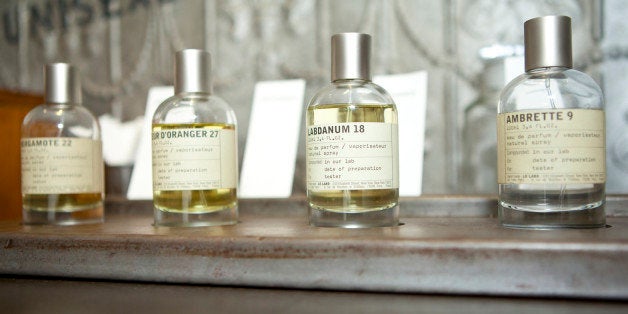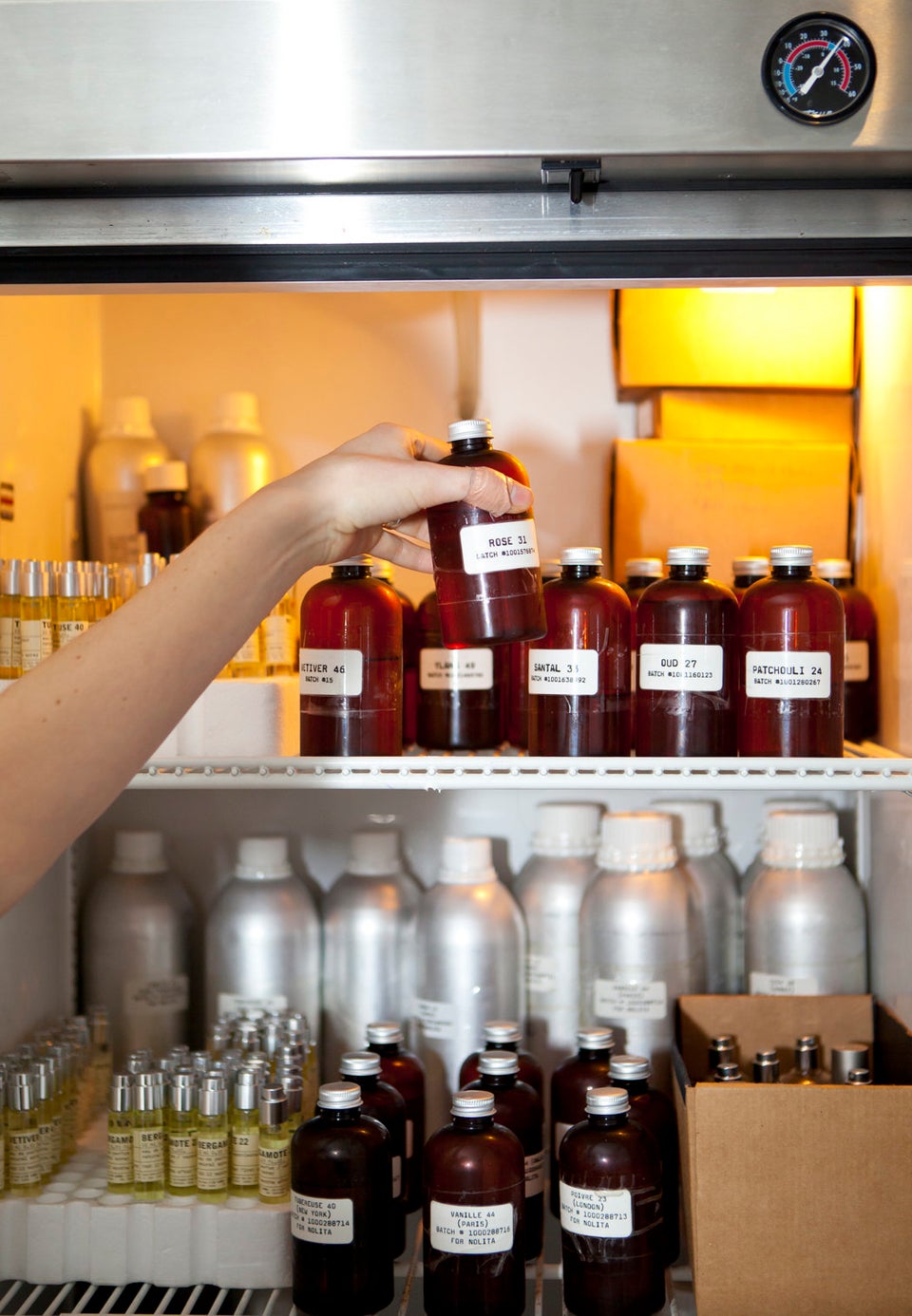
One step into Sephora's fragrance aisle, and it's easy to get overwhelmed. One by one, you pick the most attractive-looking bottles, spritz them on blotters and end up covered in a strange mixture of clashing scents. Overwhelmed, you make your final choice, leaving the store $60 poorer.
This familiar experience could be likened to speed dating, if you ask Fabrice Penot, co-founder of the French perfumery Le Labo. Since most brands only have a few seconds to please consumers, Penot says that the resulting fragrances are created to seduce olfactory senses with exploding top notes, the part of the perfume you smell for the first 15 minutes after spraying.
"It's like you meet a guy and for the first 15 minutes the guy is amazing and he's perfect," Penot says. "But after a week, the guy has no substance; there is nothing." Like this hypothetical man, Penot says, many brand-name fragrances fail to deliver a long-lasting, quality experience.

Le Labo's New York City storefront.
Those explosive top notes are just the tip of the fragrance pyramid. Once those fade away, they make room for the middle of the perfume, known as the heart. This part of the fragrance is heavier, much less volatile and can include notes like lavender and cardamom. You smell the heart for an hour or two after spraying it on.
After those two hours, you're left with the dry down of the perfume, also known as the base notes of the fragrance pyramid. These are the heaviest of the ingredients, the ones you can't smell during the first 15 minutes amid the seductive top notes. But they last. Base notes like amber, vanilla, cedarwood and musk are what stay on your sweater hours after the first spritz.
As one of the few companies in the niche, independent sector of perfumery, Le Labo aims to create an alternative to the so-called "speed dating" perfumes by focusing on a higher quality of experience, one that will not only smell richer but also last longer.
The experience of purchasing a Le Labo scent couldn't be further from the one customers get in the average Sephora or department store. The small bottles of ingredients lining the shelves of Le Labo's boutiques are perhaps the first indication that customers are in for a very different, much more personal purchase. In order to ensure freshness, everything at Labo is made to order right in front of you; nothing is "made in China" or in an unknown factory in a far-flung locale.

The crimping machine used to seal fragrance bottles made in-store.
"People come, spray, wear, think," Penot says, "It's not an act of consumerism." It's this quality of connection with fragrance consumers that Penot and his co-founder Edouard Roschi set out to establish when they started the brand seven years ago in Grasse, a town on the French Riviera.
But that mentality comes with a hefty price tag. Your average bottle of Le Labo fragrance will cost you $160, while a bottle of the brand's Tubereuse 40 will set you back a staggering $440. ("You can almost go to Paris for that much," Penot notes.) It's not hard to see why customers generally opt for that $60 bottle that excites them after a few seconds on a blotter.
What you get when you purchase a crafted, well-balanced fragrance like those Le Labo creates, though, is an emotional connection to a brand. Le Labo has such a loyal following because the founders skimp on nothing. Rose 31, for example, features rose petals plucked by hand in Grasse, which cost a few hundred thousand dollars a kilo. Penot says he recently received a letter from a woman claiming that this scent "changed her sex life with her husband."
Using such high-caliber ingredients at high concentrations doesn't leave much wiggle room for pricing. "There is almost no economies of scale in what we do," Penot says, adding that ordering two kilos or a ton of the oil they use makes no difference on the wholesale price. So while they don't spend money on advertising, marketing or distribution -- remember, the scents are all made in-store -- their ingredients can cost 40 times more than those in an average perfume, he says.
"In a way, you're getting a deal, because we're not 40 times more expensive than a $60 fragrance," Penot quips, "Obviously, you need to be able to afford our perfume. I understand not everybody is able to, which is kind of a fail of ours."

Fabrice Penot smelling the rose oil used to make Le Labo's Rose 31 fragrance.
With such a high level of craftmanship, Penot doesn't worry about competing with the celebrity fragrances constantly flooding the market -- although ironically, he feels a closer connection to celebrity fragrances than those from fashion brands like Tommy Hilfiger and Ralph Lauren. "I'd say Justin Bieber most likely has more taste and more vision [than fashion houses], because he's going to take more risks than the next designer perfume," Penot says. "Most of the others, they just make perfume to add to their bottom line."
Then again, what Penot makes at Le Labo is in another class than what Bieber would ever create. By using ingredients like rose petals straight from Grasse and focusing on a deeply personal in-store experience, the founders of Le Labo took a leap of faith to sell products with triple-digit price tags.
Luckily, Penot and his company have been able to find a small but strong customer base willing to shell out cash for an experience that exceeds expectations long after that first spritz on the blotter. The hope is that once a woman wears a fragrance crafted by Le Labo, she'll never want to "speed date" at the beauty counter ever again.
"We're building a relationship," Penot says, "Yah, I'm not going to be as joyful or as witty as the other guy, but give me a chance. Wear me and maybe take a sample, don't even buy me right away. You're going to see I'm going to change your life. I'm going to make your life more beautiful like any relationship should."
See how the folks at Le Labo craft these unique fragrances:
